Corrosion of Silver-Plated Copper Conductors - NEPP
Corrosion of Silver-Plated Copper Conductors - NEPP
Corrosion of Silver-Plated Copper Conductors - NEPP
You also want an ePaper? Increase the reach of your titles
YUMPU automatically turns print PDFs into web optimized ePapers that Google loves.
The mechanisms <strong>of</strong> redplague<br />
corrosion<br />
Figure 22. Dew-point depression below ambient<br />
temperature as a function <strong>of</strong> the relative<br />
humidity <strong>of</strong> the ambient atmosphere over a<br />
range <strong>of</strong> temperatures<br />
330<br />
The basic mechanisms that account for the red-plague corrosion <strong>of</strong><br />
silver-plated copper stranded wires and cables were briefly reviewed in the beginning<br />
<strong>of</strong> this paper. The conditions for corrosion, as stated in the literature published in the<br />
1960s, were for the simultaneous presence <strong>of</strong> moisture, imperfections in the silverplating<br />
that expose the copper core and, if the corrosion reaction is to continue<br />
unchecked, an unlimited supply <strong>of</strong> oxygen. We will now discuss the individual<br />
mechanisms in greater detail, taking into account the findings from cables found to<br />
have corroded during storage as well as those from the corrosion-susceptibility<br />
programme.<br />
Introduction <strong>of</strong> moisture<br />
Apart from capillary wetting by immersion <strong>of</strong> non-sealed wires and cables into a<br />
water bath, moisture may also be deposited on the strands by condensation. For a<br />
known ambient humidity, the dew point can be calculated and plotted 11 , as shown in<br />
Figure 22. It has already been noted that relatively large volumes <strong>of</strong> air are in Figure<br />
22. It has already been noted that relatively large volumes <strong>of</strong> air are contained within<br />
the outer jacket <strong>of</strong> certain cables. This free channel, with a volume <strong>of</strong> approximately<br />
4cm 3 per metre <strong>of</strong> cable, readily provides for the ingress <strong>of</strong> water vapour throughout<br />
the unsealed length <strong>of</strong> these and similar cables. A very limited amount <strong>of</strong> water<br />
vapour may also permeate through the walls <strong>of</strong> the outer jacket insulation. Spacecraft<br />
cable is generally stored under well-controlled environmental conditions, but rapid<br />
changes in temperature, known to occur during transportation, can cause the watervapour<br />
content <strong>of</strong> the air encapsulated within a cable’s outer jacket to become<br />
saturated and condense onto the silver braid as water droplets. As shown in Figure<br />
22, air with a relative humidity <strong>of</strong> 50% at ambient temperature will start to condense<br />
moisture onto surfaces whenever there is a 10°C fall in temperature.<br />
The strands <strong>of</strong> the inner conductor wires within the cable in Figure 7a fit tightly<br />
into their surrounding insulation. Sharp temperature falls are then unlikely to cause<br />
moisture to condense onto the wire strands (either single or multiple wires located in<br />
cables) as the volume <strong>of</strong> encapsulated air is negligible.<br />
Galvanic corrosion due to structural defects<br />
The metallographic examinations <strong>of</strong> numerous stranded wires and cables revealed<br />
defects in the silver-plating caused by:<br />
- an eccentric silver-plating coverage (e.g. poor plating distribution)<br />
- very local thin spots in the silver due to a noncircular copper core (e.g. copper wire<br />
drawn through a rough die prior to silver plating and subsequent final drawing<br />
operations)<br />
- mechanically damaged strands, invariable limited to the braid <strong>of</strong> cables (e.g.<br />
unsuitable processing equipment).<br />
ESA Journal 1984, Vol. 8



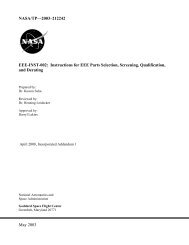

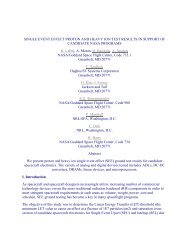
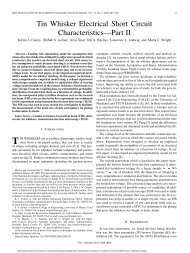
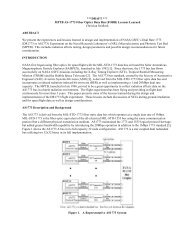

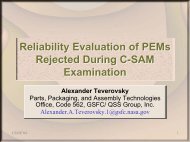
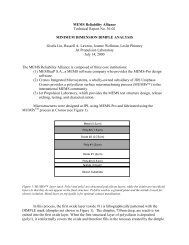
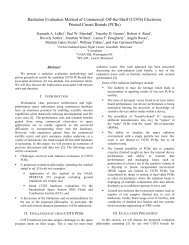
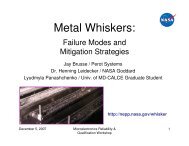

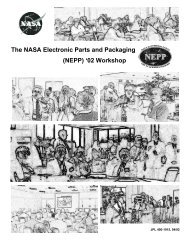

![mil-std-2223 [test methods for insulated electric wire] - NEPP](https://img.yumpu.com/4036001/1/190x249/mil-std-2223-test-methods-for-insulated-electric-wire-nepp.jpg?quality=85)